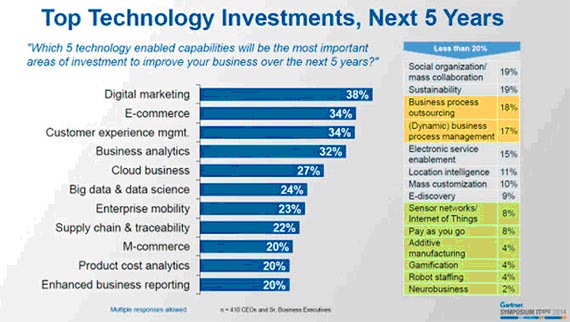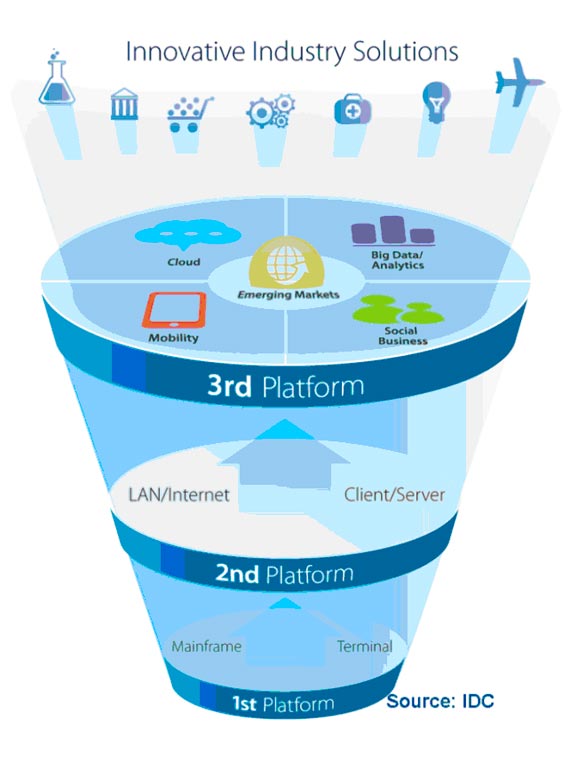Worldwide Hosted Private Cloud Services Forecast, 2015–2019


On-Demand Hosted Private Cloud
Drivers
Economics, Time to Deploy, and Industry Momentum Favor ODHPC
Assumption: ODHPC activity will rise to over 50% of cloud IaaS spend by 2016 as choice among providers grows and customers begin moving second-tier steady state workloads to cloud infrastructure. Over time, we believe that the growth rate in ODHPC will be higher as companies become more comfortable with multitenancy and providers actively push ODHPC services as competitively priced, easily provisionable options. DHPC will grow at a slightly more modest rate, particularly as a "bridge" model for traditional hosting and IT outsourcing customers looking to transition to cloud but not ready for ODHPC.
Impact: ODHPC is only a portion of the public cloud IaaS market at present but will increasingly become the default option as service providers develop and refine solutions, thus blurring the heretofore clear distinctions between "public" and "private" by providing the security, privacy, and control features of dedicated hosted private clouds on top of multitenanted public cloud delivery platforms.
Differentiated Audience Will Broaden the Buyer Base of ODHPC
Assumption: While DHPC resonates primarily with large firms, IDC views ODHPC (like public IaaS generally) playing across the entire spectrum. While large IT outsourcers have focused on DHPC as a natural extension to their business models, public IaaS operators are promoting ODHPC as a more efficient HPC alternative with the infrastructure, tools, contracts, billing, and account management characteristics of public cloud. Primary buyers for ODHPC include director-level IT development and IT operations staff as well as business unit and application development personnel in companies of all sizes.
Impact: The adoption of cloud solutions outside of IT operations continues to shift the focus of who the customer is. As line-of-business staff and developers embrace the enhanced security, performance, and control features of ODHPC, adoption will expand accordingly. In addition, as larger companies with sophisticated IT sourcing and management systems begin to centralize cloud-sourced capabilities, ODHPC, like public cloud IaaS, becomes part of the overall IT mix.
Inhibitors
Targeted DHPC Product Development and Marketing by Technology Vendors and Incumbent Service Providers
Assumption: The large incumbent hosting infrastructure and IT outsourcing providers will aggressively promote their DHPC offerings over their own or white-labeled ODHPC solutions, particularly for internal IT-focused enterprise "lift and shift" workloads and as part of datacenter rationalization strategies.
Impact: DHPC services may offer a lower-cost basis in situations such as VM or database sprawl reduction where security and control considerations may be paramount and where there is sufficient demand to justify the capacity of dedicated systems. In addition, technology vendors such as HP, Cisco, and Dell are highlighting OpenStack-based private cloud solutions to both enterprises and service providers — which could stimulate interest in on-premise/off-premise federated private cloud solutions.
Incumbent Providers and Cultural Factors Favor DHPC Outside the United States
Assumption: The ODHPC market will ramp more slowly outside the United States, particularly in EMEA and Latin America.
Impact: National/regional service providers outside North America are ramping up their product development and marketing efforts on the ODHPC front, but there are still some areas where governance, data residency, and other concerns inhibit adoption of multitenant public cloud services.
Dedicated Hosted Private Cloud
Drivers
Hybrid IT Environments
Assumption: There will be few "pure" public cloud or private cloud suppliers and offerings. Hybrid portfolios — with options for hosted (off-premise) and on-premise private clouds and external public clouds — will be the rule. As such, enterprises are beginning to view IT deployment models (both cloud and noncloud) as a continuum of choice, not as an either/or decision.
Impact: The emergence of a variety of IT cloud services — including public, private, and hybrid — gives IT shops greater flexibility in adopting the cloud model and matching the right offerings and models to specific application/workload requirements, security/compliance considerations, and overall levels of comfort with cloud technology and/or cloud service providers. This means that "going cloud" is not an all-or-nothing choice but can be a selective, gradual process.
Transition from Traditional Managed Hosting and IT Outsourcing
Assumption: Long-standing public cloud adoption inhibitors — security issues, performance and availability concerns, compliance regulations, and data sovereignty mandates — will be mitigated by DHPC services that provide many of the public cloud advantages — faster provisioning, greater agility, and transition from capex to opex technology procurement — without the perceived risks. Furthermore, the traditional managed hosting and IT outsourcing drivers remain in play for DHPC — the "opex not capex" value proposition and attractive positioning vis-a-vis DIY/in-house IT, access to IT skills/expertise, disaster recovery/business continuity, and improved performance.
Impact: DHPC will expand as this off-premises private cloud model becomes a larger part of the operational mix for enterprises with legacy applications that they simply want to "lift and shift" from on-premise datacenters and traditional managed hosting and IT outsourcing contracts. The productization efforts of the key players in the IT outsourcing and managed hosting markets (IBM, Rackspace, CSC, Dimension Data, and Fujitsu) and the service provider enablement initiatives (and acquisition activity) of trusted-brand IT vendors (Cisco, HP, Dell, Microsoft, EMC VMware, and Oracle) will ease the transition. DHPC is transforming from fully customized services built and provided based on customer requirements to standardized products and services based on a vendor's best practices.
As integrated systems and standard models are becoming increasingly important in on-premise private clouds and dedicated private clouds, "inside out" cloud bursting, disaster recovery, and distributed application deployments will emerge as more common DHPC scenarios.
Inhibitors
Vendor Lock-In Concerns and Insufficiently Open Ecosystems
Assumption: DHPC vendors may pursue proprietary stack-oriented approaches to private cloud that lack integration with a diverse ecosystem of management platforms, tools, and public cloud infrastructure alternatives.
Impact: The market growth will stall as enterprises hesitate about making the transition to a new IT model that is not sufficiently "cloudy" IT. However, IDC believes that the growing momentum of OpenStack in the private cloud arena (and service providers' growing embrace of it) will encourage adoption of DHPC for net-new steady state application/workload deployments.
Pricing Models
Assumption: Service provider pricing models for DHPC continue to align with the highly customized approach of traditional managed hosting and IT outsourcing.
Impact: Demand will stagnate or decline given that the bare metal ODHPC alternatives provide the security and isolation of DHPC at a more attractive price point and with cloudlike provisioning capabilities. However, highly productized offerings (IBM's Blue Box Cloud is one example) could close the gap with ODHPC by providing a compelling value proposition around solutions for steady state production environments with predictable pricing and add-on capacity scaling options.
The Right Cloud Can Support Application On-Boarding
To take advantage of cloud computing as part of an application upgrade, enterprises should seek a provider able to offer:
- Enterprise Application Support: Traditionally architected enterprise applications present a variety of unique infrastructure and performance requirements. An enterprise-class cloud provider will offer a service tailored to meet these needs based on enterprise-class infrastructure and best practices.
- Migration Services: Migrating existing applications to cloud demands significant requirements collection and a cohesive migration strategy. Your cloud provider should offer these services to help ensure the success of your migration.
- Enterprise Success Stories: Any provider can trot out a list of customers, but are those customers representative of your own business and its needs? The right cloud provider for your existing application migration effort should have extensive experience helping like enterprises with similar projects.
- Application-level SLAs: The reason a legacy application is still around is because the business still depends on it, and applications that the business depends on must deliver adequate levels of performance and availability. Enterprises should demand application-level SLAs when migrating existing applications to a cloud environment.
Enterprise Class Cloud for Software and Hardware Refresh
Virtustream's Enterprise Class Cloud solution, powered by xStream™ Cloud Management, offers the first truly enterprise-ready cloud solution that is both secure and compliant. Virtustream's enterprise-class cloud solution was built from the ground up to achieve the performance and reliability required to host enterprise applications.
Virtustream is well suited to assist with the migration of your enterprise applications to the cloud. Virtustream delivers:
- A Cloud Built for Enterprise Applications: Virtustream's Enterprise Class Cloud is built from the ground up to support enterprise applications. Featuring the proven VMware ESX hypervisor and enterprise-grade storage and networking infrastructure, Virtustream easily supports enterprise applications like SAP, Oracle and Microsoft right out of the box.
- Full Suite of Professional Services: Virtustream offers a full complement of cloud strategy and implementation services. We partner with your organization to provide expertise in selecting a cloud strategy, simplifying migration and accelerating adoption.
- Successful Enterprise Customers: With brand-name customer success stories by major brands such as Goodyear, SAP, Domino Sugar and Yum foods, Virtustream has the experience to ensure the success of your cloud migration.
- Application-Level SLAs: Up to 99.999% uptime SLAs for applications ensures that your business can depend on legacy applications running in the Virtustream cloud.
Enviado do meu iPhone



